(Written by William)
In this Brick Breakdown series I review official LEGO sets, from the perspective of looking at interesting building techniques we can all learn from. Today we will be looking at one of the LEGO Lone Ranger sets, the #79110 LEGO Lone Ranger Silver Mine Shootout. You can also check out the previously discussed LEGO building techniques found in official LEGO sets (including other LEGO Lone Ranger sets) at the end of this article. 🙂
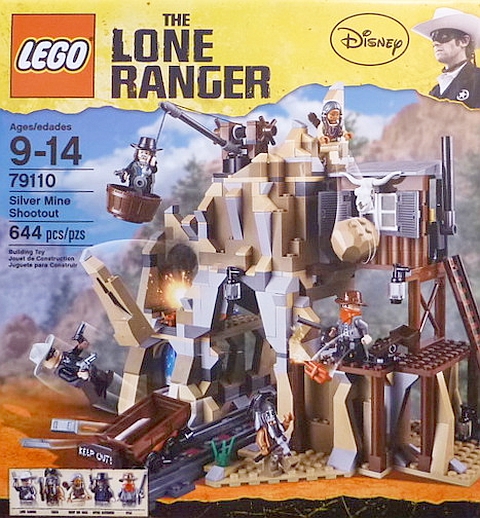
Let’s face it, if you’re going to feature outlaws in your LEGO creations, you need something to fight over. The #79110 LEGO Lone Ranger Silver Mine Shootout not only gives us that reason, but it’s a fantastic setting for all of your gun-fighting needs. On a completely different note; if you are a LEGO builder and find yourself in need of slopes for rocky outcroppings then this is the set you should pick up. It is packed with a massive amount of LEGO slopes… in fact it feels like half the set is slopes. Plus who can say no to a big brown twisty slide? The LEGO building-techniques we’ll look at in this set include a very basic but important one called “framing”, and then we’ll follow it up with a technique I was personally surprised by. We’ll call it “key-triggering” and you’ll see why below.
➡ FRAMING YOUR LEGO CREATIONS
When buildings come together in LEGO, the most important feature is the building’s frame. This is what bears the weight of the model and allows for large sections of the design to focus on decorations. Then there are sets like the LEGO Lone Ranger Silver Mine Shootout. It is not a building, but framing becomes even more important than ever. Let’s start by examining the various platforms in the set.
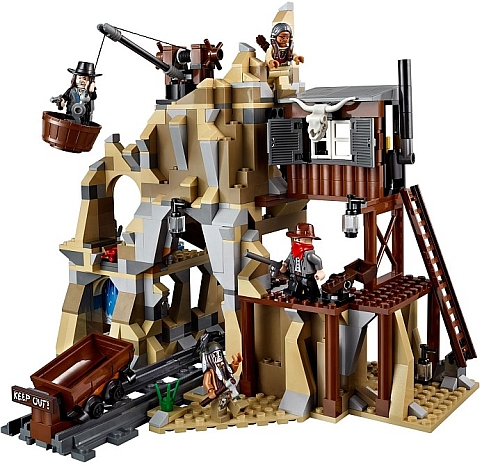
There is the running stream right under the slide, the barrel-trigger that sets off the exploding wall on the other side, and the top of the arch where the twisty slide begins. This will serve as our three examples. Notice how each platform is supported on four corners. The barrel-trigger side actually uses pillars while the stream side has many slopes disguising the underlying pillars. The end result is something that looks like a table with four legs. It’s easier to see the pillars when you have empty space between them.
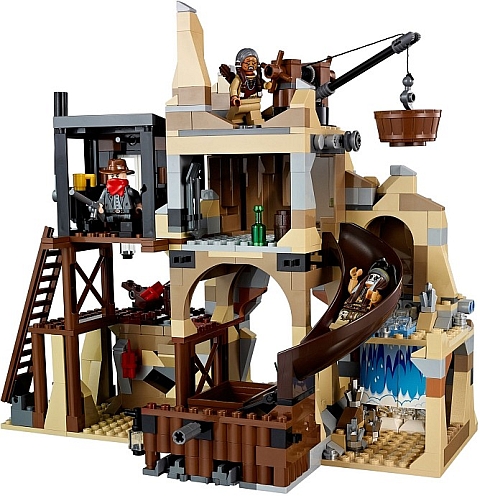
As for the top platform, its legs/pillars are the half arch pieces. So it also forms a table shape except with bowed out legs. There are even a couple of instances where there isn’t a platform above the rock-wall, but it is still framed for stability reasons. Stability is ultimately what you get from framing. As long as you know where your main supports are the rest of the LEGO model can be given over to detail work. It doesn’t matter how unconventional you make your setting, there will need to be framing so that your model has stability and can stand up correctly.
➡ LEGO TECHNIQUE – KEY TRIGGERING
The LEGO Lone Ranger Silver Mine Shootout surprised me greatly with one of the techniques it used. If you are looking at the front of the model, right above the waterfall on the left side there is a rock-wall that can be blown away. Unlike other exploding wall elements we have talked about before, pressing the action-lever is not the only thing needed to have the explosion happening. In this case, there is a hole below the wall that you can stick dynamite in. The action-lever has a sloped end that pushes the dynamite upwards, knocking the wall off. This two-step process was not only clever, but extremely thematic.
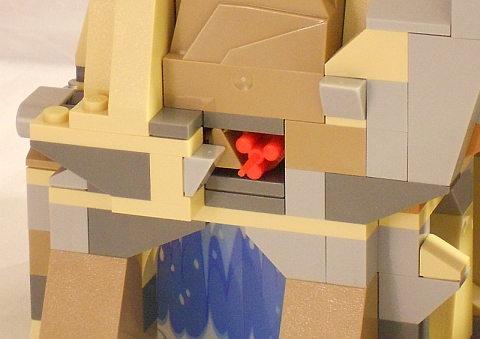
The concept is quite simple; all you need is to know where your trigger-lever ends, then leave enough space for a “key” element to fill the gap. I think the reason why this technique doesn’t get used much is because finding the right type of key that makes sense is not a simple proposition. I think the closest I’ve seen was in the #7327 LEGO Pharaoh’s Quest Scorpion Pyramid set. There you needed a sarcophagus to be in place for the lever to work and knock out a wall – same principle used in a slightly different manner. The thing that separates that action in the Silver Mine Shootout is the fact that the dynamite feels like an option rather than a necessity. There is nothing forcing you to put the dynamite in place for the explosion and because of it, there is no reason for the wall to blow up.
➡ APPLYING WHAT YOU LEARN
Framing is one of the first LEGO techniques you’ll want to master to become better at building large LEGO structures. If you need practice, I recommend creating a LEGO building just with framing. Forget the doors, windows and walls. All your attention should be on where the model feels sturdy already and where it still needs support. Once that’s done, you can go in and fill those gaps with details. (Below is a review by Nannan to show you the set.)
As for key-triggering, the important part is to pick out the right key. You will need something that makes sense for the design as well as something that would cause an action. For example, a lumber-mill might use a log for a key. It may go in and hopefully knocks over a container that has smaller pieces in the same color; the log will stay hidden in the mill while it looks like its getting cut up on the opposite end. I also recommend to continue experimenting with the dynamite and figure out other ways to use it as a key-trigger. Eventually you may be inspired to use a different key-trigger, but it will serve you well in the meantime.
So what do you think? How do you like the LEGO building techniques discussed here? Do you make sure that your LEGO projects are solidly framed? And how about adding fun exploding features with key-triggers? Feel free to share your own experiences, tips or ask questions in the comment section below! 😉
And you might also like to check out the other reviews in this series:
- Brick Breakdown: LEGO Lone Ranger Constitution Train Chase
- Brick Breakdown: Ninjago Temple of Light
- Brick Breakdown: LEGO Lone Ranger Colby City Showdown
- Brick Breakdown: LEGO Lone Ranger Comanche Camp
- Brick Breakdown: LEGO Lone Ranger Stagecoach
- Brick Breakdown: LEGO Star Wars AT-RT
- Brick Breakdown: LEGO Arkham Asylum Part 1
- Brick Breakdown: LEGO Arkham Asylum Part 2
- Brick Breakdown: Legends of Chima Polybags
- Brick Breakdown: LEGO Ninjago Samurai Mech
- Brick Breakdown: LEGO City Alarm
- Brick Breakdown: LEGO Battle of Helm’s Deep


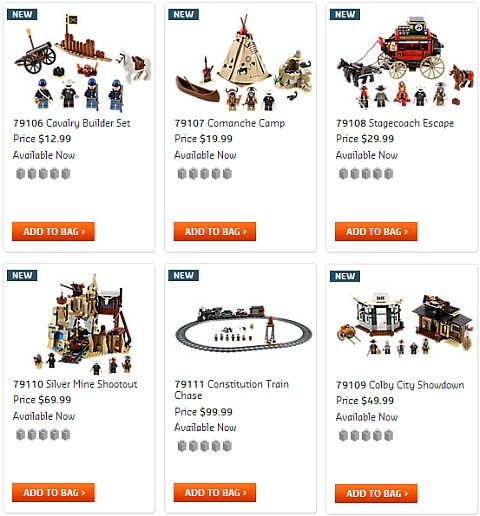










Nice tips.
Great article! I really enjoy reading the break breakdowns!
Another great post! I always enjoy your posts, William.
“brick breakdowns” definitely make the set more interesting, because you never know what kind of cool things your going to get in a set until you buy it. but these kind of things really explain what the sets are all about!
I never knew this set had a slide! (I meant to put these comments together but something just happened randomly… weird)
Yeah I never knew that either! Probably because I never really paid attention to this set….
Gold miners used these slides for washing gold, I think. It was depicted in the classic film “The Treasure of Sierra Madre”.
It’s also likely Lone Ranger or Tonto would use it in the movie, as shown in the picture.
I actually panned for gold when we lived in Arizona. Mainly found small nuggets and flakes. Nothing big like the huge chunks people find in Australia, but still quite fun. Also visited a newly-discovered gold-mine. And yes, slides are very useful. The real slides have ridges though to catch the gold. 😉
Admin, I’m almost finished with my first post! I have an idea that might turn out to be a success or maybe not. I was wondering if it is allowed the write stories for TBB. These stories I would write and they would focus on the adventures of the sleepyhead minifigure. It would be a series and each individual story would be around 1,000 words long. I would send you one each week and you would post it once a week. What do you think? If this is not allowed then that’s fine. It was just an idea I had. Thanks for reading! 🙂
I have an idea that might turn out to be a success or maybe not. I was wondering if it is allowed the write stories for TBB. These stories I would write and they would focus on the adventures of the sleepyhead minifigure. It would be a series and each individual story would be around 1,000 words long. I would send you one each week and you would post it once a week. What do you think? If this is not allowed then that’s fine. It was just an idea I had. Thanks for reading! 🙂
I think it would be more interesting if you built MOC vignettes to go with the story.
Sort of like those fan-made Lego webcomics found around the Internet.
Now that’s a thought, Hakan. I like it.
Meneldur, that’s a nice idea, and as long as pictures are included we can give it a try. I think 1,000 may be too long though. Try about half of that and see how it goes. Short and sweet is a good thing; people don’t have a long attention span online. 😉
Also, please remember that we only publish one article per day. I’m doing this on purpose so people have plenty of time to digest, discuss, etc., instead of bombarding our readers with tons of news. Quality, not quantity is what we are going for. And this also gives contributors more exposure.
However this also means that I can’t promise one day per week for your story. Sometimes there is a lot of timely news to cover, there are also more contributors now then before, so there is a lot to write about and publish. Just my list of what I want to cover is over 100 articles. What do you think about twice a month? I think I could commit to that.
Another idea you might consider is to start your own blog, publish some of the chapters here, then invite people to read more on your site. Blogging takes a lot of commitment so this may not work for you, but I just thought to mention it in case you want to give it a try. 🙂
Okay. 😀 That’s fine. I’ll probably give it a shot. I’m all done with school and have more free time. That’s partly why I haven’t sent you my article yet. Twice a month would be fine or once a month. It’ll take me a while to think of a good storyline though. I was thinking of one of the characters being Mrs. Minnie Figure.
Another idea is to post at the Message Boards. They welcome story serials with open arms. I’m writing two stories there currently, both about my favorite theme: Bionicle. One is about a long distant future, the other, which is much newer, is about the Toa Mata landing on Destral (Makuta’s base) instead of Mata Nui. However, there is the disadvantage to only having 2000 LETTERS per post…
But there’s no problem writing the story beforehand in Word or Open Office and then post it in proceeding segments, right?
Whoops. It’s supposed the be Minnie Fig.
hey guys, I’m so awesome, I put the jedi temple as my school on facebook xD
Nice!
Neat.
That is a COOL set. I wasn’t planning to get any of these sets, but I am thinking twice about it now!
It’s not surprising this would make people think of a serialized story. As it was I believe the Lone Ranger started out as a serial story.
I think for framing a good story might want to think a bit in terms of a comic book. Not so much in the presentation, but more how each installment furthers the story along.
As for the quality of this line, in general this series has some rather nice designs. The Silver Mine in particular gives a large playset with realistic rock environment, while not being the highest priced set out there.
Thanks for all the comments.